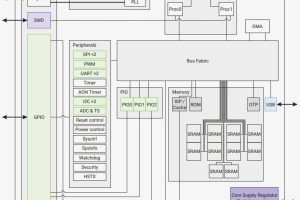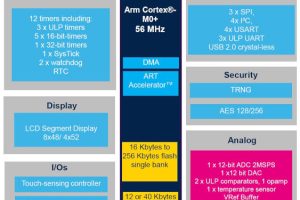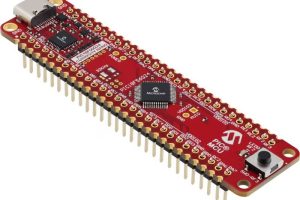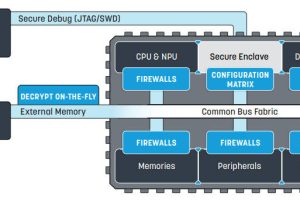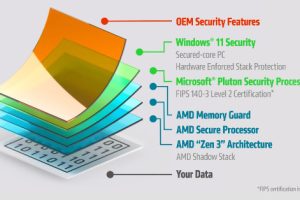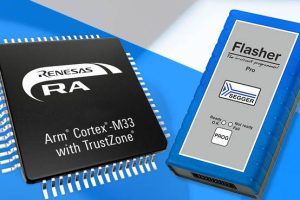Raspberry Pi’s RP2350, its second-generation microcontroller, will be available by the end of the year in flash-less and flash-inclusive forms, in two packages: RP2350A QFN60 no flash $0.80 RP2350B QFN80 no flash $0.90 RP2354A QFN60 2Mbyte flash $1.00 RP2354B QFN80 2Mbyte flash $1.10 QFN60 types are 7 x 7mm and have 30 GPIOs, QFN80 types are 10 x 10mm and ...
Tag Archives: security
Provision secure MCU features in production
Segger has introduced microcontroller security feature configuration to its in-circuit programmers, debug probes and trace probes. “Modern chips require an increasing level of customer and device-specific configuration,” according to the company. “The driving force is security, especially as more and more devices connect to the Internet. Unfortunately, there is no industry standard for provisioning device security and configuration. Options differ ...
ST cuts power from 56MHz Cortex-M0+ MCUs, and adds security
STMicroelectronics is emphasising power consumption and security for a range of 56MHz Arm Cortex-M0+ microcontrollers. Called STM32U0, the “MCUs can reduce energy consumption by up to 50% compared to previous product generations”, said the company. It “allows more designs to go battery-free, running solely from an energy-harvesting system such as a small photovoltaic cell”. On the same day, ST announced ...
MCU resists hacking via its programming interface
Microchip has upped the security of a family of PIC18 microcontrollers by adding a one-time disable to its programming and debugging interface. Called PDID (programming and debugging interface disable), “when enabled, this enhanced code protection feature is designed to lock out access to the programming-debugging interface and block unauthorised attempts to read, modify or erase firmware”, according to Microchip. The ...
Alif Semi 32bit AI MCUs for battery power
Alif Semiconductor’s 32bit ‘Ensemble’ AI-enabled MCUs are now available, according to the company. Built around various Arm cores with added security to protect stored intellectual property, they are intended to run AI algorithms locally in battery-powered devices. “There are many Edge ML applications that require 50 to 250Gop/s to become useful,” said Alif marketing v-p Mark Rootz. “Typical 32bit MCUs ...
Best practices to assure compliance with IoT security regulations
There are ways to protect data and digital identity, says Dean Zwarts, but they rely on the security of software and installed systems. Cybercriminals exploit the multiple vulnerabilities in the smart IoT devices in homes. Using smart devices, whether voice-controlled speakers, smart doorbells or light switches, hackers can access entire networks by just connecting to one system; sometimes without requiring ...
Device security needs to match Matter protocol
Security at the device level can complement existing protocols for smart devices to meets security requirements in the Matter specification, says Rohit Ravichandran. Thread and Wi-Fi protocols provide secure and encrypted wireless communication between devices. The security features of these protocols, however, protect only the transmission channels and the data flowing in them, they do not protect the end devices ...
Electronic passport security for the quantum computer era
To defend against quantum computer based hacking, Infineon and partners have revealed an electronic passport demonstrator that meets the security requirements of the quantum computing era, claims Infineon. “Today we are launching the encryption procedures which will be needed to repel quantum computer attacks of tomorrow,” said company head of identification products Maurizio Skerlj. “Working together with our collaboration partners ...
AMD ramps up security for Ryzen Pro 6000 laptop processors
AMD has released more information on its Ryzen 6000 Pro series of processors for laptops, with eight 6nm ‘Zen 3+’ cores and RDNA 2 graphics. Much of the announcement was around increased performance and longer battery life when running Microsoft office and videoconferencing software, but there was also significant emphasis on cybersecurity provisions. “We saw new threats emerge as cybercrimes increased ...
Lifecycle security and Trustzone management for Renesas RA MCUs
Segger has tied up with Renesas to add DLM (device lifecycle management) and Trustzone partitioning during mass production for Renesas’ Arm Cortex-M33 based RA4 and RA6 microcontrollers. The new features are additions to Segger’s ‘Flasher’ line of in-circuit programmers, and are available to owners of existing Flashers as a software update with “no charge, no license cost and no hidden ...
 Electronics Weekly Electronics Design & Components Tech News
Electronics Weekly Electronics Design & Components Tech News
